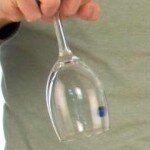Esperimenti scientifici per bambini
La biglia antigravità
Cosa serve:
una biglia e un bicchiere.
Importante: l’esperimento funziona solo con un bicchiere che sia più stretto alla base, ad esempio un calice da vino; non utilizzare bicchieri cilindrici.
Esperimenti scientifici per bambini
La biglia antigravità
Cosa fare:
la versione più semplice consiste nel mettere la biglia nel bicchiere e iniziare a ruotare sempre più velocemente: la biglia comincerà a salire e ruotare lungo le pareti di vetro. Una volta che ha preso velocità si può capovolgere il bicchiere: finchè si mantiene il movimento rotatorio, la biglia non cadrà.
La versione più elaborata e d’effetto prevede di posare la biglia sul tavolo, capovolgere su di essa il bicchiere e iniziare a ruotare. Quando la biglia comincia a scalare le pareti di vetro, sollevare il bicchiere dal tavolo. Anche in questo caso finchè si mantiene il movimento rotatorio, la biglia non cadrà.
Prima di questo esperimento si può dire ai bambini: “Scommettiamo che si può sollevare la biglia dal tavolo senza toccarla?”
Esperimenti scientifici per bambini
La biglia antigravità
Come funziona?
La forza che mantiene la biglia aderente al vetro si chiama forza centripeta.
Isaac Newton la definisce così:« … è la forza per effetto della quale i corpi sono attratti, o sono spinti, o comunque tendono verso un qualche punto come verso un centro.
Di questo genere è la gravità, per effetto della quale i corpi tendono verso il centro della terra, […] e quella forza, qualunque essa sia, per effetto della quale i pianeti sono continuamente deviati dai moti rettilinei e sono costretti a ruotare secondo linee curve.[…]
Tentano tutti di allontanarsi dai centri delle orbite; e se non vi fosse una qualche forza contraria a quella tendenza, per effetto della quale sono frenati e trattenuti nelle orbite […] se ne andrebbero via con moto rettilineo uniforme. » http://it.wikipedia.org/wiki/Forza_centripeta
Qualsiasi oggetto in movimento tende a restare in movimento seguendo una linea retta, a meno che qualcosa si metta di mezzo. Una volta in movimento, la biglia vuole continuare a muoversi in linea retta, ma le pareti curve del vetro le fanno cambiare direzione. Di conseguenza la biglia, che vorrebbe andare in linea retta, spinge contro il vetro.
Esperimenti scientifici per bambini
La biglia antigravità
Link
http://www.stevespanglerscience.com/
http://www.abc.net.au/science/
Science experiments for children – Marble gravitron
What do you need?
a marble and a glass.
Important: the experiment only works with a glass that is narrower at the base, for example a wine glass; not use cylindrical glasses.
Science experiments for children – Marble gravitron
What to do?
The simplest version is to put the ball in the glass and begin to spin faster and faster: the ball will start to rise and rotate along the glass walls. Once he picked up speed you can flip the glass: long as you keep the rotary motion, the ball will not fall.
The version most elaborate and striking It plans to lay the ball on the table, flip the glass over it and start rotating. When the ball begins to climb the walls of glass, lift the glass from the table. Also in this case as long as it retains the rotary movement, the ball will not fall.
Before this experiment can be said to the children: “We bet that you can lift the ball off the table without touching it?”

http://www.stevespanglerscience.com/
Science experiments for children – Marble gravitron
What happens?
The force that keeps the ball tight to the glass is called centripetal force.
A centripetal force (from Latin centrum “center” and petere “to seek”) is a force that makes a body follow a curved path. Its direction is always orthogonal to the motion of the body and towards the fixed point of the instantaneous center of curvature of the path. Isaac Newton described it as “a force by which bodies are drawn or impelled, or in any way tend, towards a point as to a centre.” In Newtonian mechanics, gravity provides the centripetal force responsible for astronomical orbits. https://en.wikipedia.org/wiki/Centripetal_force
Any object in motion tends to stay in motion along a straight line, unless something is put in between. Once in motion, the ball wants to keep moving in a straight line, but the curved walls of glass make them change direction. As a result, the ball, which wanted to go in a straight line, pushing against the glass.
Science experiments for children – Marble gravitron
Links
